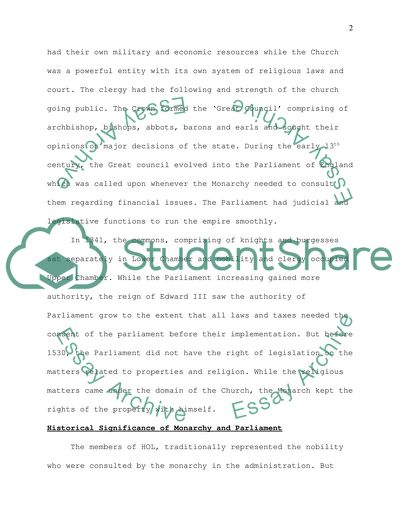Cite this document
(The Parliament of the Kingdom of England: the Relationship Between the Research Paper, n.d.)
The Parliament of the Kingdom of England: the Relationship Between the Research Paper. Retrieved from https://studentshare.org/politics/1720292-to-what-extent-can-changes-in-the-relationship-between-monarchy-and-parliament-from-1529-1640-be-seen-as-arising-from-the-long-term-financial-problems-of-the-monarchy-rather-than-from-divisions-over-the-future-of-the-church
The Parliament of the Kingdom of England: the Relationship Between the Research Paper. Retrieved from https://studentshare.org/politics/1720292-to-what-extent-can-changes-in-the-relationship-between-monarchy-and-parliament-from-1529-1640-be-seen-as-arising-from-the-long-term-financial-problems-of-the-monarchy-rather-than-from-divisions-over-the-future-of-the-church
(The Parliament of the Kingdom of England: The Relationship Between the Research Paper)
The Parliament of the Kingdom of England: The Relationship Between the Research Paper. https://studentshare.org/politics/1720292-to-what-extent-can-changes-in-the-relationship-between-monarchy-and-parliament-from-1529-1640-be-seen-as-arising-from-the-long-term-financial-problems-of-the-monarchy-rather-than-from-divisions-over-the-future-of-the-church.
The Parliament of the Kingdom of England: The Relationship Between the Research Paper. https://studentshare.org/politics/1720292-to-what-extent-can-changes-in-the-relationship-between-monarchy-and-parliament-from-1529-1640-be-seen-as-arising-from-the-long-term-financial-problems-of-the-monarchy-rather-than-from-divisions-over-the-future-of-the-church.
“The Parliament of the Kingdom of England: The Relationship Between the Research Paper”, n.d. https://studentshare.org/politics/1720292-to-what-extent-can-changes-in-the-relationship-between-monarchy-and-parliament-from-1529-1640-be-seen-as-arising-from-the-long-term-financial-problems-of-the-monarchy-rather-than-from-divisions-over-the-future-of-the-church.


